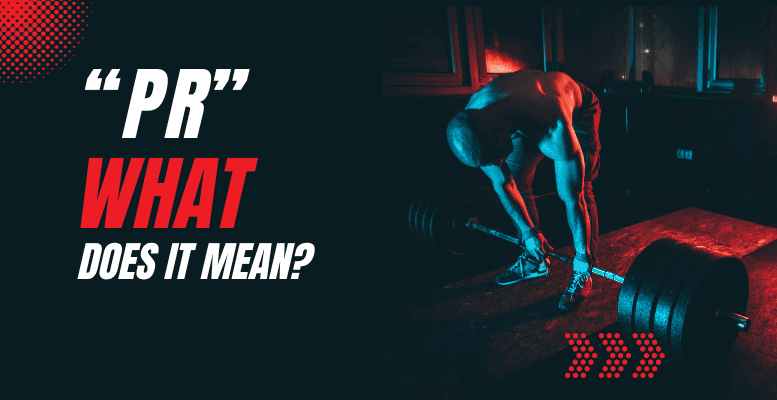Welcome to the journey of understanding what does PR means in working out. PR, or Personal Record, is more than just a buzzword; it’s a milestone in your fitness journey. Today I will go over the essence of setting and breaking personal records, providing valuable insights and strategies to help you achieve your fitness goals. Whether you’re a fitness enthusiast or a beginner, this article is your go-to resource for mastering the art of PR in workouts.

What is PR in Fitness?
Personal Records (PRs) in fitness are benchmarks that athletes and fitness enthusiasts use to measure their progress and achievements in various exercises or workouts.
This concept, central to many training regimens, helps quantify physical improvements over time. Whether lifting heavier weights, running a faster mile, or completing more reps than before, PRs are a concrete way to track and celebrate personal growth in physical fitness.
They are not just about competing with others but, more importantly, self-improvement and pushing personal boundaries. Understanding and utilizing the concept of PR can transform an ordinary workout routine into a focused, goal-oriented exercise journey.
You probably here people most often say, ” How much can you bench?” The answer would be their PR.
The Definition of PR
A Personal Record, or PR, in the fitness context, refers to achieving your highest level of performance in a specific exercise or workout to date.
It represents the best you have ever done, quantified in weight, time, distance, or repetitions. For instance, if you’ve just squatted your heaviest weight, that’s a PR in squatting.
These records are highly individualized and vary greatly depending on one’s fitness journey and training. PRs are milestones that symbolize progress and personal achievement, serving as motivational tools that encourage continuous improvement and dedication.

Importance of PR in Workout Regimes
Incorporating PRs into workout regimes has significant importance:
- They provide a clear and measurable goal, giving individuals something tangible to strive for. This aspect of goal setting is crucial for maintaining motivation and enthusiasm in training.
- Tracking PRs helps in assessing the effectiveness of a workout program. If you’re consistently setting new PRs, it’s a sign that your training is practical.
- PRs foster a sense of achievement and personal accomplishment.
Breaking a PR can be an enriching experience, boosting confidence and spurring further progress.
Setting Realistic PR Goals
Setting realistic PR goals is essential to a successful fitness journey. Unrealistic goals can lead to disappointment, demotivation, or even injury, while achievable, well-planned goals keep you engaged and moving forward.
When setting PR goals, consider your fitness level, training experience, and physical limitations. It’s essential to balance challenging yourself and recognizing your body’s limits.
Incremental goals are more sustainable and manageable than massive leaps. For instance, aim to improve your 5K run time by 30 seconds rather than 5 minutes. Remember, surpassing personal records is gradual and requires patience, perseverance, and a realistic approach.
Strategies to Achieve Your PR
Achieving your Record (PR) is not just about hard work; it’s about intelligent strategies that optimize your efforts. Setting new PRs requires focused training, proper nutrition, and systematic tracking.
It’s about understanding your body, respecting its limits, and progressively pushing them healthily and sustainably. Implementing effective training techniques, ensuring optimal nutrition and recovery, and consistently tracking and analyzing your progress are key strategies that can lead you to achieve and surpass your PR goals.
These elements work synergistically to create a solid foundation for your fitness journey, enabling you to reach new heights in your athletic achievements.

Effective Training Techniques
Practical training is at the heart of achieving new PRs. Techniques like progressive overload, where you gradually increase the intensity of your workout, are fundamental.
This could mean increasing the weight and reps or reducing rest periods between sets. Variety in your training regimen is also crucial. Incorporating different exercises, cross-training, and varying workout routines prevents plateaus and challenges your body.
Focusing on proper form is essential to prevent injury and ensure you get the most out of each exercise. Consistency in training cannot be overstated; regular workouts coupled with strategic rest days allow for continuous improvement and goal achievement.
Nutrition and Recovery
Nutrition and recovery are just as important as the workout itself when it comes to achieving PRs. Your body needs the right fuel to perform at its best and adequate recovery time to repair and strengthen itself.
A balanced diet rich in proteins, carbohydrates, healthy fats, and micronutrients is crucial for energy and muscle repair. Hydration plays a key role in performance and recovery as well.
Post-workout nutrition, particularly a combination of proteins and carbohydrates, aids in muscle recovery and replenishment of glycogen stores. Adequate sleep and rest days are essential for recovery, allowing your muscles to heal and grow stronger. Ignoring these aspects can lead to fatigue, injury, and hindered progress.
Tracking and Analyzing Progress
To effectively pursue PR goals, tracking and analyzing your progress is indispensable. This involves keeping a detailed log of your workouts, including exercises, weights, reps, and personal notes on how you felt during the session.
This data helps recognize patterns and areas of improvement and serves as a motivational tool. Reviewing your progress can help you adjust your training and nutrition plans.
Tracking also helps identify when you hit a plateau, allowing you to tweak your training regimen accordingly. Modern fitness apps and wearable technology can facilitate this process, providing insights and analytics that make tracking more accessible and practical.
![]()
Overcoming PR Plateaus
Reaching a plateau in your fitness journey, especially when striving for new Personal Records (PRs), can be frustrating and demotivating.
However, plateaus are a natural part of any training process, and overcoming them is crucial for continuous improvement.
Recognizing when you’ve hit a plateau and taking proactive steps to overcome it can reinvigorate your training and propel you toward achieving new PRs. Adjusting your training approach and, when necessary, seeking professional guidance are effective strategies to break through these stagnation periods and continue making progress.
Identifying and Addressing Plateaus
The first step in overcoming a plateau is recognizing it. A fitness plateau typically presents itself when you notice a significant halt in progress despite consistent training.
This could mean being unable to lift heavier, run faster, or improve endurance over time. Once identified, the next step is to address the plateau. This might involve analyzing aspects of your fitness regimen, like workout intensity, frequency, and variety.
Assessing other factors like nutrition, sleep, and stress levels can provide insights into why the plateau occurred. Addressing these factors holistically can help you break through the table and continue your journey toward new PRs.
Adjusting Your Training Approach
Adjusting your training approach can be highly effective when faced with a plateau. This could mean changing your workout routines, introducing new exercises, or altering the intensity and volume of your workouts.
Techniques such as periodization, where you systematically vary your training intensity and volume, can prevent your body from adapting too much to a routine, thereby avoiding plateaus.
Incorporating different types of training, like strength, endurance, and flexibility workouts, can also stimulate different aspects of fitness and contribute to overall performance improvements. Listening to your body and adapting your training approach is critical to overcoming plateaus and setting new PRs.

Seeking Professional Guidance
Sometimes, despite best efforts, overcoming a plateau might require professional guidance. Fitness trainers, coaches, or even physiotherapists can provide expert advice tailored to your situation.
They can assess your current regime, identify potential issues, and suggest modifications to your training, nutrition, and recovery strategies.
They can also provide motivation and support, helping you stay focused and committed to your goals. Seeking professional help can be a turning point in overcoming plateaus, offering a fresh perspective and expert strategies to help you achieve new heights in your fitness journey.
Conclusion
In conclusion, understanding and focusing on PR in your workouts is a game-changer. It’s about personal growth, pushing beyond your limits, and celebrating your achievements. By setting realistic goals, employing effective training strategies, focusing on nutrition and recovery, and being prepared to tackle plateaus, you can continually surpass your personal records.
Remember, the journey of improving your PR is a personal one; it’s about becoming the best version of yourself. Stay motivated, stay consistent, and most importantly, enjoy the process of reaching new heights in your fitness journey.
This post may contain affiliate links which means I may receive a commission for purchases made through links. I will only recommend products that I have personally used! Learn more on my Privacy Policy Page.
